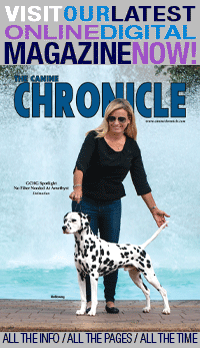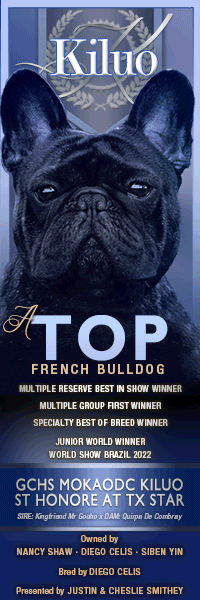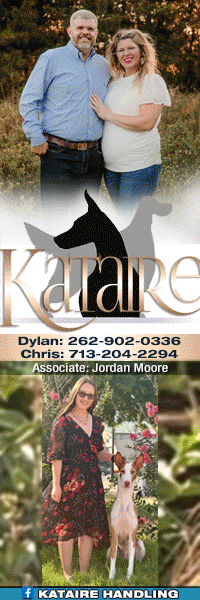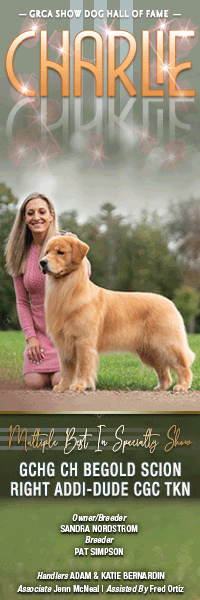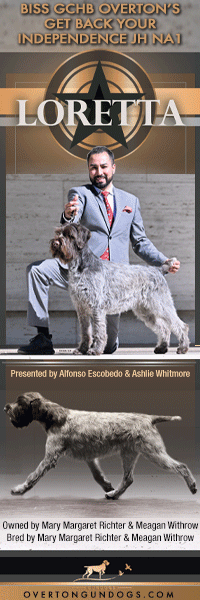The Long, Rich History of the Miniature Schnauzer
Click here to read the complete article
342 – November/December 2019
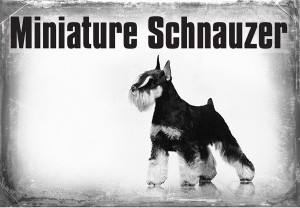 By Amy Fernandez
By Amy Fernandez
One of the astounding things about AKC has always been its militant dedication to the most contradictory concepts. The examples are admittedly endless, but if you had to pick one, the Miniature Schnauzer is a good place to start.
John Marvin was possibly the finest historian ever to chronicle AKC doings, but he definitely tended to understate things. “Today the Miniature Schnauzer is the most popular member of the Terrier group. It was not always so for in the ‘30s and early ‘40s the breed had a difficult time to become recognized as a contender.” His brief 1964 profile in The Book of All Terriers omitted most aspects of the breed’s long, strange trip to success.
This little German marvel first came to fame as an ideal pet, which of course, flagrantly contradicted its working dog heritage. But that was way before AKC added its own brand of fun to this story.
Although most purebreds emerged less than 100 years ago, they’re tried and true generic prototypes existed for centuries. Distilling them into conventional breeds was more challenging than any of those scientifically minded nineteenth-century “cynologists” had bargained on.
Very little fresh insight had been contributed to this subject since Dr. Caius wrote his famous 1576 treatise, which attempted to logically group breeds by function. For centuries writers simply deferred to his arrangement, while adding their own national slant to it, thereby ensuring absolute lack of uniformity or rationality.
This was where things stood when the nineteenth-century purebred renaissance dawned. Breeds had obviously been evolving but the nitty gritty aspects of their development had remained strictly a private enterprise.
Then all the rules changed and the entire selective breeding process was subjected to formalized criteria, although the actual process remained mostly theoretical for quite awhile. Realistic or not, no one approached it more seriously than the newly organized German kennel world. That shared dedication to excellence resulted in the creation of some of the world’s greatest breeds. Dachshund, German Shepherd, Doberman Pinscher, Rottweiler, this little niche of Western Europe cranked out dozens of purebred superstars.
But we’re focusing on the pared down version of those Pinscher/Schnauzers destined to become the Miniature Schnauzer, Miniature Pinscher, and Affenpinscher that started as nondescript farm dogs indigenous to rural Germany (long before Germany existed as a unified nation).
The Miniature Schnauzer debuted as the Wirehaired Pinscher at the 1879 Hannover show. Even though type was somewhat sketchy in terms of size, coat, and everything else, it attracted massive interest right from the start.
Yeah, well, it needed some work. Nonetheless, the Wirehaired Pinscher quickly gained traction throughout Continental Europe. The first breed standard appeared in 1880 as Germany’s kennel organizations attempted to get up to speed by recognizing divisions within the breed. But things didn’t get rolling until the Pinscher Klub was established in Cologne in 1895.
Josef Berta pops up in numerous breed histories, which suggests the scope of his influence. Armed with almost prescient self-assurance, he constantly dismissed critics and forged ahead creating his vision of at least ten breeds.
His early allegiance to this one came via his friend and mentor, Max Hartenstein. Berta inherited Hartenstein’s Plavia kennel, including at least one Schnauzer, Morro. That dog inspired Berta’s kennel name as well as his dedication to the breed which, at that point, definitely required serious imagination.
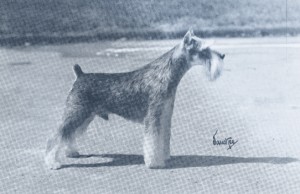 His preface of Volume I of the Pinscher Club studbook summed up the situation. “When the undersigned in the spring of 1895 advocated the foundation of a Pinscher club, there were pitifully few dedicated breeders and aficionados of our worthy native dogs. The Schnauzer, the foremost representative of the pinscher family, was a cytologic stepchild and endured a lowly existence compared to the aristocratic and highly esteemed foreigners. Lack of planning and confusion ruled the ranks; the observer was not yet greeted by uniformity in his breed, there was no tangible type to enthuse the sportsman to spend his experience and fervor on such a hopeless character.”
His preface of Volume I of the Pinscher Club studbook summed up the situation. “When the undersigned in the spring of 1895 advocated the foundation of a Pinscher club, there were pitifully few dedicated breeders and aficionados of our worthy native dogs. The Schnauzer, the foremost representative of the pinscher family, was a cytologic stepchild and endured a lowly existence compared to the aristocratic and highly esteemed foreigners. Lack of planning and confusion ruled the ranks; the observer was not yet greeted by uniformity in his breed, there was no tangible type to enthuse the sportsman to spend his experience and fervor on such a hopeless character.”
Possessing a gift for diplomacy and a flair for tyranny, Berta miraculously transformed these warring factions into focused breed development. Their ostensible goal to separate and refine all the Pinscher and Schnauzer types was edited by prevailing politics, as often happens. The Miniature Schnauzer was greenlighted through R&D and its progress was amazing considering what they started with.
The 1902 studbook documented 14 Wirehaired Miniature Pinschers. Of the eight bitches, half came from unknown lineage. Berta described the most significant foundation sire, Peter v. Westerberg, as similar to an Affenpinscher, and likewise lacking documented ancestry. Nevertheless, he was popular, siring 55 registered litters. In her 1959 book, The Complete Miniature Schnauzer, Anne Eskrigge called him the “Direct male ancestor of nearly all American Miniature Schnauzers today.”
Then there was Prinz v. Rhenstein, whelped in 1903, a “foundling whose appearance indicated a faultless mixture of Affenpinscher and Miniature Pinscher.” Berta seemed nonetheless impressed with his soundness calling him “an epoch making sire”. Prinz died young, but left three champion offspring to carry forward. His son, Gift, became a prolific sire- of both Miniature Schnauzers and Miniature Pinschers. That wasn’t an isolated case. For instance, two prominent Frankfurt kennels, Affentor and Dornbusch, interbred Miniature Schnauzer and Affenpinscher. Possibly the most influential foundation stud from George Riehl’s Dornbusch kennel was Lord v. Dornbusch, whelped in 1904. Berta was gaga over this dog, praising his square proportions, hard coat, bone and balance. But like the rest, his background was dubious, which may explain why Riehl, who bred Miniature Schnauzers well into the 1940s, never registered him. His reputation for siring parti-colored pups suggested a dash of Fox Terrier in the mix. Even so, three of his sons founded important male lines.
As Eskrigge admitted, well into the 1920s European studbooks revealed puppies from the same litter being registered as Miniature Schnauzer, Affenpinscher, or sometimes Standard. “No doubt breeders experimented with various crosses when attempting to improve bone, body, head and coat.” As a case in point, she noted that Michel Chemnitz Plauen, whelped in 1920 and registered as a Min Pin was sired by a Miniature Schnauzer Sieger winner saying “both parents played an important role in early Miniature Schnauzer pedigrees.” Anyway, creative experimentation ruled the day, which was probably the only possible route to success considering the size and variability of the gene pool. Any semblance of predictable type was a long way off.
In 1918, Berta orchestrated the merger of the Pinscher Klub with its rival, the Beyerischer Schnauzer Klub. The resulting organization known as the PSK (Pinscher-Schnauzer Klub) joint-ly published its first studbook in 1924 right around the time the breed arrived in America.
Miniature Schnauzer imports poured into America. Between 1925-35, 108 arrived from the Continent. However, the breed’s true start came in 1924 when Mrs. Marie Lewis imported four startup dogs for her kennel in South Lincoln, Mass.
Boston bred and dog crazy, Marie’s background ran the gamut from Fox Terriers to Borzoi, Bulldogs, Irish Terriers, Bull Terriers, and Bostons. By 1920 she had settled on German Shepherds, then she experienced one of those life changing moments.
She owned 30 German Shepherds when she abruptly switched to Miniature Schnauzers in 1923. She’d read about them, but never actually saw one until her first imports arrived from Germany. By then she was an old hand at importing, having brought over several German Shepherds. But it was more than that, she knew she was on the right track, having already chosen her new kennel prefix, Marienhof, by combining her name with her daughter’s.
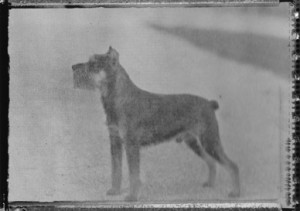 The beginnings of Marienhof arrived in fall 1924. The prize of that shipment was Amsel v.d. Cyriaksburg. Daughter of a Sieger winner, Amsel had an “excellent” rating. Accompanying her were her eight-week-old daughters, Lotte and Lady v.d. Goldbachhoehe, and a male out of Dornbusch breeding. Unfortunately, the male quickly succumbed to distemper and it was another year before Marie could get another stud from Germany.
The beginnings of Marienhof arrived in fall 1924. The prize of that shipment was Amsel v.d. Cyriaksburg. Daughter of a Sieger winner, Amsel had an “excellent” rating. Accompanying her were her eight-week-old daughters, Lotte and Lady v.d. Goldbachhoehe, and a male out of Dornbusch breeding. Unfortunately, the male quickly succumbed to distemper and it was another year before Marie could get another stud from Germany.
Cuno von Burgstadt came to Marienhof in May 1926 and within the next six years he would sire 33 American champions, but it was his German-born son, Sieger Marko von Beutenberg, that really made his reputation as a producer. Marko came to Marienhof later, after Cuno was on the losing end of a dogfight. So Cuno was the star of those early years. His celebrated offspring included five champion siblings bred by Mardale, the first Miniature Schnauzer kennel to earn an AKC Gazette feature back in April, 1931. Owned by Mrs. Isaac Warner Jeanes, Mardale was definitely in keeping with her ritzy tastes. The Jeanes family was top-notch Philadelphia blueblood ensconced at their ancestral manor in Chestnut Hill.
Like Marie, Lucy Newhall Jeanes came to Miniature Schnauzers after decades of dabbling in many breeds–Cockers, Fox Terrier, Skyes, Maltese. By then, she had settled on Pekes, the best naturally, procured from the nearby, much celebrated Orchard Hill Kennels.
Lucy’s introduction to this breed was likewise pure chance. “Mrs. Jeanes knew nothing of the Miniature Schnauzer until three years ago. It is true, she had heard of them, but never had she come in actual contact with them. Meeting a handsome pair at Cherbourg, France, the owner of Mardale determined to purchase some of this breed.” The paint was barely dry on the actual Mardale kennel when Jones arrived. “Since Chestnut Hill is a restricted area it was obviously impossible to build a kennel there.” Like Marienhof, Mardale’s creation was rapid and drastic. Shortly after that fateful encounter on the docks at Cherbourg, Lucy not only arranged to import the first of many Miniature Schnauzers from Germany, she purchased five acres of property and commenced building her dream kennel 12 miles away at Belfrey Station, where presumably the zoning laws were more congenial. Jones raved about its picturesque grounds, intriguing color scheme, and thrilling modern conveniences, especially the newest fireproofing technology which fascinated him to no end.
Not surprising, considering that the substantial Jeanes family fortune traced back to a 1000 acre land grant signed by none other than William Penn. So, yeah, it was fancy, glossy, and Jones was suitably impressed. Mardale then housed around 40 dogs and would shortly get much bigger after the untimely passing of Mr. Jeanes in 1935. After that, Lucy maintained her official residence at posh Springdale House and spent most of her time over at Belfrey Station overseeing her increasingly fabulous kennel.
Apparently, the source of many of her winners wasn’t yet dazzly enough to merit mention in Jones’s 1931 article. But Lucy was already plugged in with Marienhof. Her prime acquisition at that time was Ch. Lotte v. Goldbachhoche, one of those original imports. She had already produced ten AKC champions and would hold the record of 12 champions for 25 years until Ch. Sorceress of Ledahof, another Mardale acquisition, topped it in 1959. When Jones visited only one of that famous all champion litter, Timon, had finished but as he noted, littermate Rudi had recently scored a colossal Westminster upset, taking Breed over the Standard.
At that point, Miniatures and Standards were shown in combined Schnauzer classes with one representative proceeding to Terrier competition after their recent ejection from the Working Group. John Marvin was not the only one perplexed by this decision. Marvin was obsessed with facts and his argument cited sources all the way back to 1884-the year of AKC’s founding, but let’s leave his discontent with this comment. “Here is the only breed presently recognized in the Terrier group that is not of basic British origin. Many have said that the Schnauzer is not a Terrier and should not be shown in the Terrier group. This view is held in Great Britain, where the English Kennel Club classifies the Standard and the Miniatures Schnauzer as Non-Sporting dogs. Even in Germany, its native land, the Schnauzer is not considered a Terrier.”
True, FCI created the Pinscher/Schnauzer group to accommodate these breeds, similar to their special Dachshund classification. The Kennel Club placed the breed in Utility, somewhat akin to Non-Sporting. America and Canada are the only countries where the breed remains misclassified as a Terrier.
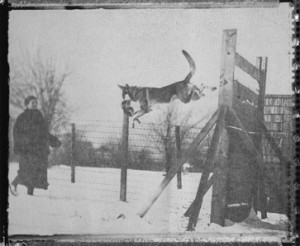 Still, it’s important to consider the big picture. The Miniature Schnauzer had the good (or bad fortune) to enter the AKC machine at a pivotal moment in purebred history. You might say it came of age in tandem with modern AKC structure. By then, the organization’s viability finally seemed secure and it was time to tackle other stuff, like housecleaning. This long overdue project was enough to make Marie Kondo faint. For the past 50 years almost every breed had been stuffed into the increasingly irrelevant Non-Sporting category. Basically, they employed the junk drawer approach to breed classification, which works fine until that day of reckoning when the contents must be subjected to some rational plan.
Still, it’s important to consider the big picture. The Miniature Schnauzer had the good (or bad fortune) to enter the AKC machine at a pivotal moment in purebred history. You might say it came of age in tandem with modern AKC structure. By then, the organization’s viability finally seemed secure and it was time to tackle other stuff, like housecleaning. This long overdue project was enough to make Marie Kondo faint. For the past 50 years almost every breed had been stuffed into the increasingly irrelevant Non-Sporting category. Basically, they employed the junk drawer approach to breed classification, which works fine until that day of reckoning when the contents must be subjected to some rational plan.
Actually, the breed seemed to make tremendous progress at first. AKC recognized in February, 1926, it had its first AKC champion in 1927, Don v. Dornbusch, and its first Ambred champion, Ch. Moses Taylor, a double grandson of Amsel. Moses and Don actually finished the same day at different shows. A year later, the Czech import Ch. Dolf v. Feldschlosschen, became its first group winner. Of course, these achievements obscured the fact that Miniature Schnauzer’s reputation was truly outpacing the genetic underpinning holding type together.
Josef Berta was resolute about his ideas although many of them seemed quite deranged at the time. For instance, he was possibly the earliest authority on record demanding structural soundness in Toy breeds. (We’re still waiting in some cases.) He predicted global popularity for the Miniature Schnauzer way before it possessed any semblance of coherent type. But even he couldn’t have envisioned some of the obstacles in that path to glory. AKC first recognized the breed as Wirehaired Pinscher (Toy and Standard). When it was subsequently shifted out of Miscellaneous in 1926 it was initially sent to Working where separate BOBs were awarded to Miniatures and Standards with both competing in group. Schnauzer fanciers actually scored a major victory that year getting the name revised from Wirehaired Pinscher.
Then in 1931 AKC decided that only one BOB winner should compete in group (that was the year of Mardale’s exciting Westminster win). Through 1932 both sizes were simply designated as Schnauzers and competed for one BOB award. In spring 1933 AKC again reversed that policy, reinstating separate BOB awards for Miniatures and Standards. The precise criterion differentiating breeds and varieties wouldn’t be hashed out for awhile.
By 1934 Marie had more than earned her coveted Gazette kennel feature. Then living in Rock Island, Illinois married to Capt. John W. Slattery, Jones didn’t hesitate to call Marienhof “the foundation of the Miniature Schnauzer breed in the U.S.” Captain Slattery’s army career had necessitated lots of moves for his family from New England to the Southwest and back. Incredibly, the breeding program never skipped a beat. They finally settled in Rock Island and really got to work. They had imported numerous important dogs, produced 27 champions and provided foundation stock for bloodlines coast to coast. Marienhof eventually bred over 60 champions during its 40 year history.
Adversity can forge Esprit de Corps and Lucy and Marie had abundant company by 1934. Jones wasn’t exaggerating when he said “This hardy little breed has progressed further in this country of its adoption than in its native Germany.” Germany was no picnic in those days, and because of that, American breeders were able to acquire dogs that would have normally never been offered for sale.
Shortly after being relocated to the Terrier Group, the Schnauzer Club of America held its inaugural specialty with the Combined Terrier Clubs Show in February, 1927. And yes, it was won by a Miniature, Hitofa’s imported Sieger winner and soon to become AKC Ch.Don v. Dornbusch. Frank Spiekerman of Greenwich, Conn., best known for his celebrated Hitofa Scotties, was another early supporter of this breed.
Right after Hitofa scored a major coup acquiring Don v. Dornbusch, Isabel Sloane’s Brookmeade Kennel went one better bringing over his equally famous dam Seigerin Lenchen v. Dornbusch. Heir to the Dodge auto fortune, she is best known for the Triple Crown prospects bred at her Brookemeade Stables. But she also got in on the ground floor of Miniature Schnauzers and remained part of it until her death in 1964. Lenchen was one of many Brookemeade winners presented by Frank Brumby and later by Tom Gately who was then Brumby’s apprentice. Gately would soon strike out on his own, marry Katherine, establish their Gayterry Kennel in Wilton, Connecticut and eventually become the first superstar husband and wife handling team in what was still a very male dominated profession. The Gatelys presented big winning Wires and Kerry Blues and were among the first major Terrier handlers to dominate this breed. They also maintained a successful racing stable at their farm in Pineville Pennsylvania. Sloane’s affiliation with Len Brumby and Tom Gately was more than business. These were likeminded individuals who understood the nuts and bolts of quality breeding. Yes, there was a ton and a half of money wrapped up in this endeavor but no one onboard was naive enough to expect instant results. And that was good because those were interesting times.
 AKC dithering was just a backdrop to the main issue confronting breeders- sorting through this genetic ball of confusion. Although some of those imports were knockouts, those PSK bloodlines were just two steps ahead of Min Pin, Fox Terrier, Affenpinscher, and who knew what else. Despite some wonky surprises, American fanciers imported at a brisk pace. That was lucky, because although no one knew it at the time, WWII would soon slam the door on European bloodlines. From then on, American breeders had to work with what they had. And this was still a dangerously small gene pool. By 1935, all 54 Ambred champions traced to ten imported dogs and eleven imported bitches.
AKC dithering was just a backdrop to the main issue confronting breeders- sorting through this genetic ball of confusion. Although some of those imports were knockouts, those PSK bloodlines were just two steps ahead of Min Pin, Fox Terrier, Affenpinscher, and who knew what else. Despite some wonky surprises, American fanciers imported at a brisk pace. That was lucky, because although no one knew it at the time, WWII would soon slam the door on European bloodlines. From then on, American breeders had to work with what they had. And this was still a dangerously small gene pool. By 1935, all 54 Ambred champions traced to ten imported dogs and eleven imported bitches.
Flatcoated pups were not unusual. Bicolors also popped up with dismaying regularity and thanks to decades of Miniature/Standard intermixing, uniform size remained work in progress. Some issues, such as stabilizing type and quality in Blacks, would plague breed development for decades. All things considered, it’s understandable that the Miniature Schnauzer had trouble catching on.
This was certainly not the only breed to experience a resultant identity crisis thanks to AKC’s continuous rearrangements. When their grand plan for the group system emerged in 1924 they truly weren’t prepared for the logistical nightmare of properly assigning every recognized breed to its appropriate group. However, the collateral damage in this particular case was enormous although the extent of it didn’t come into focus for awhile. Needless to say, breeds with politically powerful clubs definitely had an advantage in this situation. And even that was proving to be really complicated for this group.
Specialty clubs were prevalent by then, and some like the Collie Club and the Spaniel Club enjoyed massive power within AKC. That kind of leverage was well-understood. So this group wasted no time organizing the Wirehaired Pinscher Club of America in 1925. With George Sloane as president and Mrs. Morgan Belmont as VP, this lineup was all that. However, their initial success getting the breed’s name revised turned out to be a one-off victory. AKC soon decreed that the club could not represent both sizes- so in 1933 it was forced to disband and restyle as two organizations- concurrently with bouncing the breed in and out of groups and breed divisions.
On August 19, 1933 the American Miniature Schnauzer Club began with 32 members and Mrs. Isaac Jeanes as first president. By 1935 AMSC was hooked up with M&E. Breeds participated in this internationally fabulous event by private invitation only, which posed no barrier for the likes of Jeanes, Belmont, and Sloane. That specialty drew an impressive entry of 52 and was won by Ch. Aennchen of Marienhof. Bred by Marie and owned and campaigned by Lucy Jeanes, in 1930 she’d become the breed’s first bitch champion and first American-bred to win a group. Aennchen was one of nine champions from that frequently repeated Cuno x Lotte breeding that clicked beyond anyone’s expectations. She was also the rarest and most coveted purebred phenomenon, a showstopper and a top brood bitch.
Her daughter, Ch. Mehitabel of Marienhof was widely predicted to surpass her show record, but bad luck intervened. Eskrigge said, “That she never won the Associated Terrier Specialty is probably due to the fact that Miniature Schnauzers participated in this event only once during her career, when in accordance with the AKC rule at that time no award for Best Miniature was made.” Then she unfortunately died in whelp. Her daughter, Mehitabel of Marienhof II, equally outstanding, was never officially a champion. All her wins were canceled because she accumulated them with cropped ears from 1930-34, when the new standard instituted a cropping dq. “She died before she could rewin her championship title.” Losing a championship and a pile of top awards is truly demoralizing but Marienhof came right back with Mehitabel III, who became the breed’s first uncropped group winner in 1934. In his Marienhof profile that year, Jones casually noted “all the furor kicked up about the anti-cropping laws seems amusing to the owners of Marienhof especially when they look at the beautiful small ears on Ch. Porgie of M and Ch. Priscilla of M.”
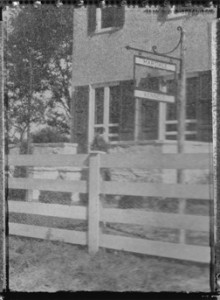 Not everyone was amused by this new rule specifying that “dogs entered in contravention of state laws forbidding the exhibition of cropped dogs shall be disqualified.” Yes, on top of everything breeders had to begin selecting for ear shape, size, set, and symmetry. Eventually, the standard was again revised permitting both cropped and uncropped ears, but that regulation had spelled the death of more than one British Terrier. Thankfully, this group not only had the foresight and skill to devise workarounds for these overwhelming challenges, they had the grit to ride out the storm.
Not everyone was amused by this new rule specifying that “dogs entered in contravention of state laws forbidding the exhibition of cropped dogs shall be disqualified.” Yes, on top of everything breeders had to begin selecting for ear shape, size, set, and symmetry. Eventually, the standard was again revised permitting both cropped and uncropped ears, but that regulation had spelled the death of more than one British Terrier. Thankfully, this group not only had the foresight and skill to devise workarounds for these overwhelming challenges, they had the grit to ride out the storm.
Things seemed to settle down in the ‘40s but that was most likely due to the overall drop in purebred activity during WWII. AKC didn’t fail to spice it up again, transferring the Standard Schnauzer back to Working . The normally unflappable John Marvin couldn’t refrain from commenting on this endless irrationality by saying, “In this country, a kind of anomaly arises out if the 1945 action of the Standard Schnauzer Club of America which requested the AKC to transfer the breed from the Terrier to the Working group which was done on July 10, 1945. In spite of all these conditions the Miniature Schnauzer remains classified as a Terrier in the US and Canada.”
There it was, the Standard Schnauzer returned to its more logical classification, leaving the Miniature masquerading as a Terrier, its presence as unexplainable as ever but by then I guess everyone was accustomed to a lot of stuff making no sense at all. The breed truly did seem impervious.
Nothing proved that more convincingly than Dorem Display. Dorothy Williams was a decade into her Dorem breeding program when this prize package arrived on August 5, 1945. Display stood 13 inches tall. He was short-coupled, with a good hard coat, excellent head and neck, and unsurpassed showmanship. He embodied the new streamlined type that came to define the breed after WWII.
Winning back to back Westminster Best of Breeds in 1948 and 1949, he became the first Miniature Schnauzer to take the group that year. He also became its first all breed BIS winner in 1946 and retired with five BIS and four specialties. His stunning show career turned the tide of public interest in the breed, but it paled in comparison to his stud career which was concurrent with his show campaign. Only ten months old when his first son finished, he soon outstripped the 20 champion record held by his great great grandsire, Ch. TMG of Marienhof. He died in 1959, having sired 42 champions. His story is even more impressive when considered in context because that was no golden age for Terriers.
There were warning signs, but nobody bothered about those details back then except maybe Life Magazine. In 1948 they analyzed breed trends from the start. This was the cusp of America’s purebred mania and big changes were looming. However, Terriers had dominated the sport for so long, their supremacy was taken for granted. Actually, as Life revealed, they had steadily lost ground for years and by 1948 an entirely new range of breeds began overtaking the picture–Cockers, Beagles, Collies, Dachshunds, Pekes, Poms, Boxers and German Shepherds. The entire Terrier Group paradigm was upended.
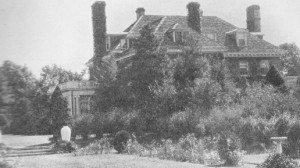 “The gain in popularity of the Miniature Schnauzer during recent years has been phenomenal. Starting from scratch as a complete unknown in 1924, Miniatures ranked eighth in AKC registrations in 1966 and seventh in 1967 with 26,001 registered that year.” It happened fast and Eskrigge saw it all. When the breed first entered AKC’s top ten in 1965 it had been top Terrier for three years. In that 14 year span from 1956-1969 it soared from 24th to fifth in all breed ranking. That panned out to 1147 championships, 1189 obedience titles and 63 all breed BIS wins-no other Terrier came close. Yes, popularity ushered in a familiar dark side as Eskrigge conceded, “An increase of 23.7 percent over 1966 is not an altogether happy situation for any breed.”
“The gain in popularity of the Miniature Schnauzer during recent years has been phenomenal. Starting from scratch as a complete unknown in 1924, Miniatures ranked eighth in AKC registrations in 1966 and seventh in 1967 with 26,001 registered that year.” It happened fast and Eskrigge saw it all. When the breed first entered AKC’s top ten in 1965 it had been top Terrier for three years. In that 14 year span from 1956-1969 it soared from 24th to fifth in all breed ranking. That panned out to 1147 championships, 1189 obedience titles and 63 all breed BIS wins-no other Terrier came close. Yes, popularity ushered in a familiar dark side as Eskrigge conceded, “An increase of 23.7 percent over 1966 is not an altogether happy situation for any breed.”
True. Excessive popularity was admittedly a new brand of crisis but it wasn’t the first rodeo for this crew. By then, disaster management was second nature. One way or another, AKC had constantly upped the ante on the Miniature Schnauzer’s odds of survival. Breeders never had the luxury of basking in their success. That simply wasn’t an option when every day brought a new shocker. The consequent siege mentality literally defined its evolution in America and probably played a major role in its improbable success. Maybe it was pure accident, but it’s more comforting to think there was some method to the madness and AKC knew what they were doing all along.
Click here to read the complete article
342 – November/December 2019
Short URL: http://caninechronicle.com/?p=174445
Comments are closed
